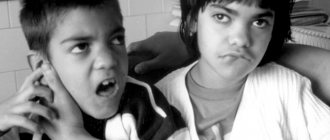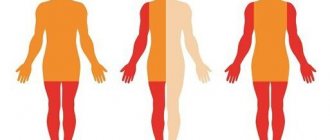Children are the meaning of life for many people. How wonderful it is when they are small, cheerful, kind, and sympathetic. And how painful and worrying it is when they get sick. And if this disease also leads to the fact that the child begins to be very different from other children, the child does not develop according to the standard, then this causes complete horror in the parents. Many parents perceive the diagnosis of mental retardation as a death sentence for their children and a punishment for themselves. But is this really so?
Oligophrenia is a disease in which a child experiences underdevelopment of the brain, as a result of which his physical, intellectual, and emotional abilities are severely limited. Oligophrenia can be congenital, or it can be acquired at an early age. Scientists name the following reasons for oligophrenia:
- adverse intrauterine effects (abdominal trauma during pregnancy, infectious disease suffered during pregnancy);
- genetic abnormalities (chromosomal abnormalities, gene mutations);
- difficult birth (fetal asphyxia, head injury, prematurity);
- pedagogical neglect of a child in early childhood.
About 1% of the population suffers from oligophrenia to one degree or another. The main features of oligophrenia are reduced mental and physical abilities.
Causes of mental retardation
Oligophrenia is congenital, manifesting itself at the earliest stage of human development.
It's quite common. It is believed that the pathology occurs in 1% of the population. Of the total number of patients, mild degree is determined in 85%, moderate in 14%, and severe in 1%. Experts suggest that in fact the disease is even more widespread, since not all patients undergo a psychiatric examination. Boys get sick more often than girls. The main age for detecting pathology is 6-7 years. Mild forms are detected by the age of 17-18 years. Obvious deviations make themselves felt in the first years of life and require emergency treatment. The main causes of dementia:
- Intrauterine damage to a developing child due to traumatic brain injury during childbirth, asphyxia.
- Chromosomal abnormalities: Down syndrome, Williams syndrome. Angelman, fermentopathy and other pathologies.
- Infectious diseases of the mother leading to disruption of normal brain development. We are talking about neurosyphilis, herpes, cytomegalovirus, rubella, toxoplasmosis,
- Prematurity.
- Parental substance abuse.
- Intrauterine diseases: hydrocephalus, meningoencephalitis.
Causes of mental deviation
Among the factors that influence the occurrence of mental pathology are the following:
- genetic predisposition to the disease. In approximately half of cases, mental retardation is inherited;
- chromosomal disorders, gene abnormalities, their mutation due to radiation, infectious diseases, maternal use of toxic substances during gestation;
- severe labor, which led to injury to the child (especially in the case of head injury), asphyxia, cerebral hypoxia;
- premature birth;
- infectious diseases affecting the central nervous system;
- lack of education, negative atmosphere in the family, psychological trauma at an early age, late diagnosis of the disease, etc.
It should be noted that to date scientists have not been able to find a single cause of mental retardation. As a rule, the occurrence of the disease is associated with several unfavorable factors that occur simultaneously or alternately.
COST OF TREATMENT FOR MENTAL DISEASES
The duration of treatment in a hospital is from 14 to 90 days, depending on the severity of the disease.
TREATMENT IN A HOSPITAL.
AMBULATORY TREATMENT
TREATMENT IN A HOSPITAL
Inpatient treatment – accommodation options
| Accommodation in a triple room | 10,000 rub./day |
| Double room | RUB 13,800/day |
| Single room of increased comfort | 16,000 rub./day |
| Treatment in a single VIP ward | 25,000 rub./day |
AMBULATORY TREATMENT
Ambulatory treatment
| psychiatrist | FOR FREE |
| Consultation with a psychiatrist (first appointment) – free of charge during hospitalization | 3,000 rub. |
| Full psychodiagnostics (all tests and procedures) | from 5,000 rub. |
| Appointment with the head physician of the clinic | 4,500 rub. |
| Consultation with a psychiatrist at home | from 4,000 rub. |
FREE CONSULTATION
Prevention of oligophrenia
Since mental retardation is very often caused precisely by problems of intrauterine development, preventive measures include:
- registration in the housing complex before 12 weeks of pregnancy;
- regular visits to the pregnant gynecologist, timely testing, ultrasound diagnostics;
- quitting smoking and drinking alcohol;
- taking daily walks in the fresh air;
- quality rest (sleep at least 8 hours a day);
- rational and balanced nutrition;
- the use of gentle methods of obstetrics, refusal of obstetric forceps.
This article is posted for educational purposes only and does not constitute scientific material or professional medical advice.
Stages of mental retardation
More recently, the traditional view of the types of oligophrenia has been revised.
Previously highlighted:
- Debility is the easiest type of intellectual disability.
- Imbecility – cases of a moderate form of developmental disorder.
- Idiocy is an advanced stage.
Each of these types was in turn divided into three degrees of severity.
Modern medical classification has excluded these terms for a number of reasons. The most significant is the penetration of terminology into the spoken language with a clear derogatory connotation.
At the present stage of psychiatry, there are 4 types of mental retardation:
- Lightweight, appropriate for debility.
- Moderate, from a clinical point of view, being uncomplicated imbecility.
- Severe, manifested by an advanced imbecile clinic.
- Deep, inherently idiotic.
THE ESSENCE OF THE PROBLEM
Mental retardation is a serious limitation in the skills necessary for daily life, social and intellectual activities. Such individuals experience problems with speech, motor development, intelligence, adaptation, emotional-volitional sphere, and cannot interact normally with the environment.
This definition was given by AAIDD - the American Association for Developmental and Intellectual Disabilities, which changed its approach to this problem. It is now believed that providing ongoing, personalized support can improve the quality of life of a mentally retarded person. Yes, the term itself was replaced with a more tolerant and inoffensive one – “intellectual disability”.
In addition, such a disease is now not considered mental. And it should not be confused with developmental disabilities. The latter covers a broader area, but is very closely related to the first: autistic disorders, cerebral palsy, etc.
Oligophrenia is a chronic non-progressive disease that occurs as a result of brain pathology in the prenatal period or after birth (up to three years).
Despite the achievements of modern medicine and serious preventive measures, it cannot give an absolute guarantee that this disease will not appear. Currently, 1 to 3% of people worldwide suffer from UO, but most suffer from a mild form (75%).
There is also acquired mental retardation - dementia. This is a separate “age-related” pathology in older people, a consequence of natural brain damage and, as a result, the collapse of mental functions.
Signs and symptoms of mental retardation
With oligophrenia, there is a systemic lesion of all types of mental functions that requires treatment.
Patients suffer from all intellectual abilities:
- attention;
- memory;
- emotional sphere;
- speech reproduction
- ability to perceive and analyze information.
Many patients develop movement disorders, diseases of internal organs, and neurological disorders.
Clinical manifestations of intellectual development defects depend on the form of severity and are important for deciding how to treat mental retardation and what the patient’s relatives should do.
Mild degree of dementia
Patients have an IQ of 50-70.
Main features:
- Low ability for abstract thinking.
- Inability to generalize.
- Lack of critical abilities.
- Predominant figurative and concrete thinking.
- Poor vocabulary.
- Emotional poverty.
- Increased suggestibility against the background of stubbornness.
With these disorders, this category of patients experiences:
- Good mechanical memory.
- Clear ability to perform routine activities that do not require creativity.
- Adaptability to life.
Persons with intellectual disabilities often have external defects:
- Irregularly shaped ears.
- “Mongolian fold” - epicanthus.
- The absence of part of the eye membrane is a coloboma.
- An increased distance between the eyes is hypertelorism.
- Defects of the heart and other organs.
Manifestations may require treatment not only from a psychiatrist, but also from other specialists.
Moderate to severe dementia
In this category of patients, IQ is in the range of 20-49.
They are characterized by:
- Flat (rudimentary) thinking.
- The ability to develop basic skills of self-care and neatness.
- Small vocabulary.
- Complete lack of ability to generalize the properties of phenomena and objects.
- Helplessness in any situation requiring intellectual effort.
- Tendency to mechanical imitation.
People with this pathology can perform primitive, routine work under control. They are either aggressive, or, on the contrary, timid and inhibited. They often exhibit hypersexuality and an increased appetite to the point of gluttony.
Profound degree of insanity
IQ in this case does not exceed 20.
When examining patients, the following is revealed:
- No signs of thinking.
- Inarticulate pronunciation of sounds.
- Complete misunderstanding of addressing them, lack of differentiation of people nearby.
- Inability to perform basic self-care skills.
- The presence of elementary emotions (joy, displeasure).
- Decreased response to stimuli.
Patients are in a supine position (fetal position). They require constant care and treatment. The prognosis is unfavorable.
Treatment of oligophrenia
Treatment of oligophrenia in the stage of debility and imbecility consists of correcting existing intellectual defects with the help of:
- correctional schools;
- speech therapists, teachers specializing in the development of speech, thinking, social skills and attention.
For mental retardation in the idiocy stage, treatment is reduced to caring for the patient in a psychiatric hospital or a home for the mentally retarded/disabled.
Neurologists, defectologists and psychologists working with mental retardation sufferers set themselves the goal of maximally adapting them to self-care and life in society. Very often, sick children live in isolation. Even their closest relatives do not understand them, which only aggravates the situation.
A rehabilitation plan for each patient is developed individually. This takes into account the degree of mental retardation, the presence/absence of somatic and neurological disorders, and characteristics of physical development.
Diagnosis of mental retardation
Detection of mild degrees of the disease in early childhood is difficult. The diagnosis is made by observing a child with suspected oligophrenia.
During the examination, the doctor takes into account the following data:
- Developmental delays.
- Conversations with relatives and the patient, during which all specific manifestations of the disease are identified.
- Psychological tests, questionnaires, analysis of the interpretation of sayings, proverbs, pictures and drawings.
The examination is supplemented by genetic techniques, MRI, CT, and encephalogram. Differential diagnosis is necessary to exclude schizophrenia.
SUPPORT FOR PEOPLE WITH ID
This disease develops in different ways, but it is very important to diagnose it as early as possible. In this case, specialists will begin to work closely with such a patient at an early age, which significantly improves his condition and quality of life.
Such assistance is necessarily personalized, that is, it is planned taking into account the individual characteristics of the patient, his needs and desires. People with this diagnosis are not the same, therefore, help for each of these individuals in the sphere of life and certain activities should have its own type and intensity.
In many countries of the world, including ours, special programs have been developed whose goal is to improve the quality of life of people with mental retardation. They are integrated, “dissolved” in society. Children with mild degrees of the disease go to auxiliary schools and kindergartens, inclusive classes in regular educational institutions. There are even groups in vocational schools where you can get an education and then work in your specialty.
How is the cause of RRR determined?
In order to cure a disease, you need to know exactly why it appeared. The cause of a delay in speech development in a child can be determined by conducting a comprehensive examination of him with doctors of traditional medicine; naturopaths do not need all examinations, but it will not hurt to undergo them.
Pass special testing to determine whether the child’s skills correspond to his age.
Bayley Scale Early Language Development Scale
Denver test Have your hearing checked by an audiologist Determine facial motor dysfunction - difficulty swallowing Compare the processes of understanding speech and producing it Analyze the ways adults interact with a child Determine how well the brain works using MRI, EEG and other methods See a child psychologist and psychiatrist and also visit a speech therapist and neurologist
Classification
Based on the results of intelligence tests using the Wechsler method, better known as determining IQ (normally, this indicator should be above 80, IQ between 70–80 is considered a borderline form of developmental delay), 3 stages of oligophrenia are distinguished:
- mild (moronic), IQ 50–70;
- moderate (imbecility stage), IQ 35–49;
- severe and deep (pronounced imbecility and idiocy), IQ less than 34.
How to treat ZRR?
Early diagnosis of such problems allows you to prescribe appropriate treatment in time and, in some cases, successfully get rid of them.
Traditional medicine and doctors suggest combining the following methods:
- Taking medications prescribed by a neurologist or psychiatrist. They are designed to nourish the neurons of the brain - Cortexin, Lecithin, Neuromultivit, etc.
- Modern hardware procedures , such as: reflexology and magnetic therapy They can activate the brain and improve speech, but have many contraindications
- Classes with a speech pathologist and speech therapist according to individually designed programs, which include various game exercises
- One of the types of speech therapy massage , selected for each specific child
- dolphin or hippotherapy as additional treatment methods.
We suggest you replace drug treatment with a unique recovery program - effective and safe. After all, only living products can effectively enter a cell and work there.
FDD, like any other delays in the development of a child, has dangerous social consequences
lagging behind peers problems with studying further acquisition of a profession
Therefore, the main task of parents of such special children is to notice the problem in time and competently get rid of it.
Features of children with mental retardation
Disturbances in the intellectual sphere of children who have developmental delays are relatively mild, but all intellectual processes are affected: perception, attention, memory, thinking, speech.
The perception of a child with mental retardation is fragmented, slow and inaccurate. Some analyzers operate at the same level as in normally developing children, but a child with mental retardation will have difficulty forming a holistic image. Visual perception is better developed than auditory perception. This feature is important to take into account when teaching such children: they definitely need visual aids to better assimilate the material. In children with mental retardation, such properties of perception as objectivity and structure are impaired (recognizing objects from an unusual angle causes them certain difficulties), including the integrity of perception. Children with mental retardation have difficulty identifying individual elements of an object, which they perceive as a single whole, find it difficult to complete a complete object based on part of it, and find it difficult to guess what is in front of them if only part of the object is shown.
As for attention, in children with mental retardation it is unstable, short-term, and superficial. The child is distracted by any extraneous stimuli, it is difficult for him to concentrate on any one activity, so situations related to concentration cause great difficulties. In addition, their selectivity and distribution of attention are impaired. They cannot assess which stimulus is significant in order to concentrate on it and which is not. Even a small stimulus can distract them from completing the main task.
Memory in children with mental retardation is characterized by fragmented memorization of material, poor selectivity, and a predominance of visual-figurative memory over verbal memory. They remember visual stimuli better and faster than auditory ones. Their involuntary memory is more preserved. In addition, children with mental retardation have a low level of self-control in the process of memorization and reproduction, the inability to independently organize their work to memorize the necessary educational material, insufficient cognitive activity and focus when memorizing, and the inability to use memorization techniques.
As for thinking, in children with mental retardation, visual-effective thinking is more intact, while figurative thinking is more impaired due to the fact that they are characterized by inaccurate perception. As for abstract-logical thinking, its development and functioning is impossible without the help of an adult. Children with mental retardation have difficulty with analysis and synthesis, comparison, and generalization, so they cannot cope with tasks related to the ordering of events, build an inference, they cannot make a generalization and formulate conclusions based on it.
Speech in children with mental retardation also has its own specifics. They have a distortion of the articulation of many sounds, a violation of auditory differentiation. Their vocabulary is limited. Such children have a violation of control over the grammatical form of speech; it is much more difficult for them to construct coherent, literate statements. Therefore, their speech may seem quite illiterate and too simple.
With regard to written speech, children with mental retardation often experience such phenomena as dysgraphia and dyslexia. In psychoneurology, dyslexia is understood as a violation of the reading process, and dysgraphia is a violation of the writing process. Children with dyslexia make mistakes when reading: they miss sounds, add unnecessary ones, and distort the sound of words. Reading speed with dyslexia is low, children change places of letters, and sometimes miss the initial syllables of words. With dysgraphia, children have difficulty mastering writing: everything they write contains a fairly large number of grammatical errors. When writing, they do not use capital letters, punctuation marks, confuse letters with similar spellings, combined and separate spelling of prepositions and prefixes. Their handwriting, as a rule, is ugly, sloppy and incomprehensible. In middle and high school, schoolchildren try to use short phrases with a limited set of words when writing, but this does not save them from making quite serious mistakes. Such children write and read much more slowly than their peers.
The formation of the personal sphere in children with mental retardation also has a number of features. It is characterized by excessive emotional mobility, frequent mood swings, and suggestibility. They are characterized by lack of initiative and lack of will; they rarely become the life of the party, leading in any activity, but follow the lead of their peers. In addition, they may experience affective reactions, increased aggressiveness, and increased anxiety. This can lead to serious conflicts with other people.
But more often, children with mental retardation are withdrawn and uncommunicative. Unable to adapt socially, they prefer to play alone and avoid contact with peers. Their gaming activities are stereotypical and monotonous, the plot of the game is one-dimensional, very simple. They play as if according to a template, their imagination is quite stingy.
Features of the motor skills of children with mental retardation include awkwardness, clumsiness, and lack of coordination. They are often susceptible to such phenomena as hyperkinesis (pathological sudden involuntary movements in one or an entire group of muscles following an erroneous command from the brain) and tics (this is a rapid involuntary stereotypic muscle contraction).
Reviews about the clinic
Here you can undergo a course of treatment for mental retardation in order to improve the patient’s adaptive capabilities. Often, the patient’s relatives do not have enough information about treatment methods, duration of therapy and stages of the disease. On this page you can read reviews from real people that contain information of interest.
We do not influence their content in any way; we constantly improve the quality of service and improve our qualifications. Any of our patients who want to express their opinion on the pages of our resource can leave a review. If you do not find the information you are interested in, call our call center. The specialist on duty will provide reliable information within a few minutes.
How to prevent mental development problems
Good and effective prevention of childhood mental retardation is based on the early and comprehensive development of children. In general, medical experts advise the child’s parents to adhere to the following simple rules in order to prevent mental retardation.
- It is necessary to create optimal conditions for a woman’s successful pregnancy and childbirth.
- In a family where a small child is growing up, a favorable and friendly environment must be created.
- If the baby develops any diseases, they must be treated in a timely manner.
- From the first days after birth, the baby’s condition must be carefully monitored.
- From an early age, you need to constantly work with your baby, developing abilities and skills.
In the prevention of mental retardation in children, contact between mother and baby on an emotional and physical level is of great importance. The child will feel calm when his mother hugs and kisses him. Thanks to attention and care, the baby better navigates his new surroundings and learns to adequately perceive the world around him.
We would also like to recommend educational rugs - your child will definitely love them!










